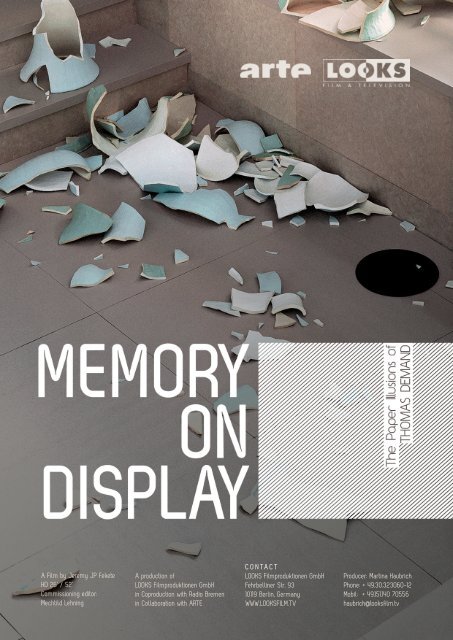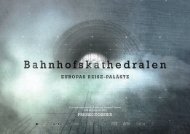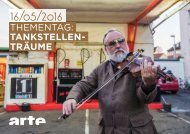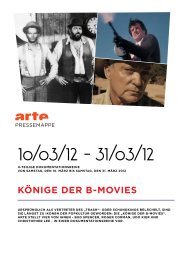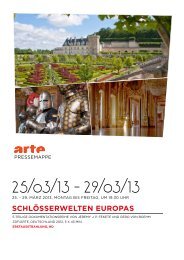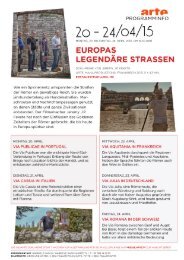Das Spiel mit der Erinnerung - Die Bilderwelt des Künstlers Thomas Demand
- ARTE/LOOKS FILM
- ARTE/LOOKS FILM
Create successful ePaper yourself
Turn your PDF publications into a flip-book with our unique Google optimized e-Paper software.
A Film by Jeremy JP Fekete<br />
HD 26’ / 52’<br />
Commissioning editor:<br />
Mechtild Lehning<br />
A production of<br />
LOOKS Filmproduktionen GmbH<br />
in Coproduction with Radio Bremen<br />
in Collaboration with ARTE<br />
C O N TA C T<br />
LOOKS Filmproduktionen GmbH<br />
Fehrbelliner Str. 93<br />
10119 Berlin, Germany<br />
WWW.LOOKSFILM.TV<br />
Producer: Martina Haubrich<br />
Phone: + 49.30.323060-12<br />
Mobil: + 49.151.140 70556<br />
haubrich@looksfilm.tv
<strong>Thomas</strong> <strong>Demand</strong><br />
Oval Office<br />
Oval Office<br />
THOMAS DEMAND<br />
He had his first solo show in 1991,<br />
on the day when the art bubble<br />
bursted in America. Fourteen years<br />
later a retrospective of his work is<br />
on display in the New York Museum<br />
of Mo<strong>der</strong>n Art. One of his pieces,<br />
»Oval Office«, was commissioned<br />
for the cover of the New York<br />
Times Magazine. Today, his work is<br />
represented by five galleries from<br />
New York to Tokyo and his photographs<br />
are commanding six figure<br />
sums.
03<br />
MEMORY ON DISPLAY<br />
The Paper Illusions of THOMAS DEMAND<br />
Badezimmer<br />
<strong>Thomas</strong> <strong>Demand</strong>, internationally acclaimed<br />
as a »photographer«; but yet not your usual<br />
photographer, takes photographs of models;<br />
photographs that are mostly recreations of<br />
specific places. He builds life-sized models out<br />
of pasteboard and paper in his studio that are<br />
inspired by incidents he finds in the media and<br />
private photos. Even though the models require<br />
the greatest expenditure in the work process, he<br />
photographs them, <strong>des</strong>troys and then dis poses<br />
them afterwards. Regarding this he resembles a<br />
Ceremonial Master during the Baroque period<br />
who with tremendous expenditure also created<br />
the perfect illusion of an artificial world for just<br />
one festive evening.<br />
His final photographic product, each one perfectly<br />
mounted behind a mirror-like Plexiglas,<br />
evokes the collective memory. The viewer sees<br />
well-known visual images of scandals and political<br />
or social events which have become part<br />
of our common visual consciousness long ago.<br />
As much as <strong>Demand</strong> reduces the images to a<br />
few necessary details, the viewer develops his<br />
own fantasy being confronted with the all too<br />
familiar media images.<br />
This happens with the »Badezimmer« (Bath<br />
Room), where the Minister President of Schleswig-Holstein<br />
was found dead in a bathtub in a<br />
Geneva hotel in 1987; the old seating arrangements<br />
of the German parliament when it was<br />
located in Bonn; the devastated room in the<br />
Wolf’s Lair that Hitler left just before a bomb<br />
detonated.<br />
<strong>Demand</strong> creates abstractions of these buildings<br />
and rooms that we only know from photo graphs.<br />
He creates them so that we can recognize that<br />
they are constructed – by his choice of perspective<br />
or of the moment. We can only tell the shot<br />
has not been taken at the original location because<br />
all individuality and every letter have been<br />
erased. With these strange historical locations,
04<br />
MEMORY ON DISPLAY<br />
The Paper Illusions of THOMAS DEMAND<br />
Heldenorgel<br />
Büro<br />
who seem to be free of history, <strong>Demand</strong> creates<br />
a staged <strong>des</strong>ign for the amorphous shapes of<br />
our collective memory. He <strong>des</strong>cribes it as such:<br />
»It is not the event itself that interests me, but<br />
rather the diffuse and shadowy existence that<br />
they lead to in the shadowy and diffuse realm<br />
of our memory.«<br />
This film is not intended to become a portrait of<br />
<strong>Thomas</strong> <strong>Demand</strong>. He would even refuse that. In<br />
his private sphere, as in his work, the reduction,<br />
the minimum, the omission of the persona is<br />
also a leitmotiv that runs through <strong>Demand</strong>’s un<strong>der</strong>standing<br />
of who he is. Even more, the stories<br />
of the locations that have been »cleared up«<br />
by him need to be further examined. The facts<br />
along with the personal backgrounds he keeps<br />
referring to in his exhibitions neither indicate<br />
nor do they explain.<br />
In the piece »„Heldenorgel« (Hero Organ), the<br />
viewer sees is an impressive work, a battle between<br />
pasteboard and paper. But is the 3 x 2 meter<br />
photo image pure craftsmanship or an very<br />
artistic use of glue? The laconic title, »Heldenorgel«,<br />
gives us a hint that something huge is being<br />
presented. But who still remembers this myth?<br />
Even <strong>Thomas</strong> <strong>Demand</strong> didn’t know anything of<br />
its existence until an artist friend placed an old<br />
postcard in his hand. It immediately cought his<br />
interest – a resonating World War I memorial<br />
– which became a victim to the collective amnesia<br />
of an entire nation.<strong>Thomas</strong> <strong>Demand</strong> begins<br />
to examine the lost memory. He drives to Kufstein<br />
in the Tyrol to Austria, where the largest<br />
free-standing organ in the world is enthroned.<br />
4,307 organ pipes stand in a row like canons<br />
un<strong>der</strong> the roof of an old fortress. With a certain<br />
amount of admiration, <strong>Demand</strong> still talks about<br />
how this object gradually revealed itself to him.<br />
The song »Vom Guten Kameraden« (The Good<br />
Comrade) has been played on this organ, which<br />
has been donated by veterans of the First World<br />
War since 1931, in memory of their fallen comra<strong>des</strong>.<br />
It reverberates from the mountain top to<br />
the valley, to Germany and Austria and beyond.<br />
»Not as brut as the Holocaust Memorial in Berlin<br />
which became a bulky obstacle that stands in<br />
the way of visitors, than rather a memorial that<br />
performs well,« as <strong>Demand</strong> <strong>des</strong>cribes this form<br />
of honoring the dead. Just on the day the artist<br />
called the director of the local music school,<br />
who was assigned to play the organ every day,<br />
the dismantling of the organ pipes was in progress.<br />
The mayor was turning the instrumental<br />
performance into a tourist attraction. Because<br />
of this the organist resigned her job, due to the<br />
objection to this plan. <strong>Demand</strong> set out for the<br />
memorial right away and twelve hours later he<br />
arrived in Kufstein.<br />
While the craftsmen were working in the back<br />
with their screwdrivers, the music teacher<br />
played on the instrument at the artist’s request<br />
for a last time. »Nothing but minor chords, like<br />
the end titles of a film that didn’t had a happy<br />
end,« he recalls. Since refurbishing the pipes,
05<br />
THOMAS DEMAND<br />
Parlament
06<br />
MEMORY ON DISPLAY<br />
The Paper Illusions of THOMAS DEMAND<br />
Clearing<br />
they number 4,948. The song, »The Good<br />
Com rade«, could be heard once again at noon<br />
throughout the entire town – with a favorable<br />
wind up to ten kilometers away. The booming<br />
notes could even be heard on the top of the<br />
»Wilden Kaisers«. With his art, <strong>Thomas</strong> <strong>Demand</strong><br />
restored the `heroic organ´ for the public<br />
memory.<br />
<strong>Demand</strong> also has quite a sense of humor – as<br />
demonstrated in his piece, »Landing« (Landing).<br />
It was inspired by the picture of a mobilephone<br />
photograph, shoot by a museum visitor,<br />
that showed the results from an accident in<br />
the Fitzwilliam Museum of Art and Antiques in<br />
Cambridge, England.<br />
In January 2006, a man stumbled over his shoe<br />
string and fell down some stairs on three 300<br />
year old vases from the Quing Dynasty. All three<br />
vases broke. This mobile phone snapshot of<br />
the bizarre accident quickly found its way to<br />
the Internet and even the museum set up an<br />
extra Internet site about the clean up and the<br />
re sulting restoration process. The accident became<br />
a media coup for the museum. »In April<br />
that same year, the man was officially arrested,<br />
un<strong>der</strong> the suspicion that he had intentionally<br />
tied his shoe strings together to gain attention,«<br />
added <strong>Thomas</strong> <strong>Demand</strong>. Incontestably, <strong>Demand</strong><br />
has accentuated the comedic side for his reconstruction<br />
of this photograph of the accident.<br />
Even the working title speaks plays with linguistic<br />
slapstick: »Landing« is on the one hand a<br />
common architectural term and at the same<br />
time it <strong>des</strong>cribes a bizarre event with a twist on<br />
the meaning of the word.<br />
On the other hand, the objects in »Gate« or<br />
»Kitchen« tell complete dramas: The yellow<br />
telephone next to the safety lock that was not<br />
removed, because the mur<strong>der</strong>er was not recognized;<br />
the matches the fallen tyrant Saddam<br />
Hussein used to warm his coffee in his rabbit<br />
hole while a war raged outside.<br />
The themes <strong>Demand</strong> has made use of are multilayered,<br />
from an apparently coincidence to<br />
trivial happenings to the unforgettably tragic.<br />
Whether referring to political events or simply<br />
owing to the beauty of nature, all of his artworks<br />
never fail in their effect. He made a name<br />
for himself with an annoying, beautiful forest<br />
we saw in a photograph in which succulent,<br />
deep green leaves were bathed in a bright early<br />
morning light, a forest like the ones French<br />
landscape painters once painted; and ambitious<br />
wildlife journalist loved to portray. The perfect<br />
forest that the Berlin artist pre sented in his five<br />
meter wide monumental photograph, »Clearing«,<br />
was a scenery made from paper that was<br />
created with an very nearly monumental expenditure<br />
of time and energy in his Berlin studio.<br />
His assistants wrapped no less than 270,000<br />
sheets of paper on the artificial branches for<br />
months on end. The sun in this clearing, which<br />
looks more beautiful than any forest imaginable,<br />
shines from his studio lamps.
07<br />
THOMAS DEMAND<br />
Büro
08<br />
MEMORY ON DISPLAY<br />
The Paper Illusions of THOMAS DEMAND<br />
REALIZATION<br />
Gate<br />
Grotto<br />
In approaching <strong>Thomas</strong> <strong>Demand</strong>’s work cinematographically,<br />
we will forgo juxtaposing his works of art with the original<br />
locations. These »Before and After« effect would not do justice<br />
to <strong>Demand</strong>’s own originals. This approach will be used right up<br />
to or after the moment captured in <strong>Demand</strong>’s magnum opus.<br />
In or<strong>der</strong> to narrate the authentic as well as the personal backgrounds<br />
of his staged photographs, these portraits must themselves<br />
be set in the scene again to preserve the memory game<br />
– even while being watched on a television monitor.<br />
For this, his art should be taken up and distributed using artificial<br />
and conceptional transposition on film. His »cleared up« images<br />
are revived again in the background inasmuch as, for example,<br />
his naturalistic works like »Stroh« (Straw), »Rasen« (Lawn), return<br />
to nature to stage them there in front of waving corn fields<br />
to clarify <strong>Demand</strong>’s fascination with the structure of nature.<br />
Each take will always remain a mysterious moment – whether<br />
we drive to Kufstein to the Hero Organ to get closer to <strong>Demand</strong>’s<br />
explanation or to the accident at the English Fitzwilliam Museum<br />
in or<strong>der</strong> to provide the feeling of the original moment – the<br />
alienated viewpoint will constantly be emphasized.<br />
The exhibition at the Berlin National Gallery 2009/2010 provi<strong>des</strong><br />
the framework for the film. The images shot there on the one<br />
hand are remarkably suitable as short, recurring way stations and<br />
on the other hand as entry and exit points for the various levels<br />
of the film. By focusing on one of the images we begin to plunge<br />
and dive in these stories and backgrounds.<br />
Original music and archive material from previous exhibitions<br />
compliment the search for the hidden agendas of <strong>Demand</strong>’s<br />
»worlds«.
09<br />
MEMORY ON DISPLAY<br />
The Paper Illusions of THOMAS DEMAND<br />
INFORMATION<br />
Landing<br />
A Film by Jeremy JP Fekete<br />
CONTACT<br />
Length: 26’ & 52”<br />
Format: HD Cam<br />
A production of LOOKS Filmproduktionen GmbH<br />
in Coproduction with Radio Bremen<br />
in Collaboration with ARTE.<br />
Commissioning editor: Mechtild Lehning<br />
C O N TA C T<br />
LOOKS Filmproduktionen GmbH<br />
Fehrbelliner Str. 93<br />
10119 Berlin, Germany<br />
Producer: Martina Haubrich<br />
Phone: + 49.30.323060-12<br />
Mobil: + 49.151.140 70556<br />
E-mail: haubrich@looksfilm.tv<br />
WWW.LOOKSFILM.TV


